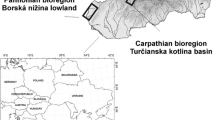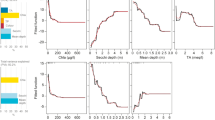Abstract
Aquatic macrophyte species richness (SR) was examined at 430 sites in the central Canadian region in relation to water body type, bottom substrate and 8 water chemistry parameters. SR was highest in rivers and lakes, intermediate in creeks, and lowest in ponds. The highest values occurred where granitic bedrock, highly organic substrates or sand predominated. SR was significantly inversely correlated in the study area as a whole with 7 of the water chemistry parameters; of these, total alkalinity was the most important. However, the relative importance of the respective parameters differed for various water body types. The relationship between SR and phosphorus was positive in ponds, but negative for all other water body types. Stepwise sultiple regression analysis identified phosphorus, total alkalinity and dissolved organic matter as important factors in ponds; sulphate, total alkalinity and chloride in lakes, and sulphate and phosphorus in lotic habitats. Log transformations improved the correlations for some variables. However, the water chemistry parameters examined accounted for less than half of the total variability in SR. Apparently SR depends on many different factors, including surface areaand bottom type, whose relative contributions vary with situation.
Similar content being viewed by others
References
AMERICAN PUBLIC HEALTH ASSOCIATION 1971. Standard methods for the examination of water and wastewater. Amer. Public Health Assoc., N. Y., 874 pp.
DE LANGE, L. and J.C.J. VAN ZON, 1983. A system for the evaluation of aquatic biotopes based on the composition of the macrophytic vegetation. Biol. Conserv., 25: 273–284.
DIAMOND, J.M., 1969. Avifaunal equilibria and species turnover rates on the Channell Islands of California. Proc. nat. Acad. Sci. (Wash.), 64: 57–63.
FOREST, H.S., 1983a. Submersed macrophytes in the Finger Lakes as ecosystem indicators. Proc. 26th Conf. Great Lakes Res., Oswego, N.Y., p. 43 (Abstract only).
FOREST, H.S., 1983b. Diversity of submersed macrophytes in glacial lakes of Europe and North America: relationship to water quality. Proc. 26th Conf. Great Lakes Res., Oswego, N.Y., p. 33 (Abstract only).
FRASER, D. and J.K. MORTON, 1983. Aquatic plants in Lake Superior Provincial Park in relation to water chemistry. Can. Field-Nat., 97: 181–186.
HELLQUIST, C.B., 1980. Correlations of alkalinity and the distribution ofPotamogeton in New England. Rhodora, 82: 331–344.
KADONO, Y., 1982a. Occurrence of aquatic macrophytes in relation to pH, alkalinity, Ca++, Cl− and conductivity. Jap. J. Ecol., 32: 39–44.
KADONO, Y., 1982b. Distribution and habitat of JapanesePotamogeton. Bot. Mag. Tokyo, 95: 63–76.
LASSEN, H.H., 1975. The diversity of freshwater snails in view of the equilibrium theory of island biogeography. Oecologia (Berl.), 19: 1–8.
MACARTHUR, R.H. and E.O. WILSON, 1967. The theory of island biogeography. Princeton Univ. Press., 203 pp.
MILLER, G.E. and H.M. DALE, 1979. Apparent differences in aquatic macrophyte floras of eight lakes in Muskoka District Ontario from 1953 to 1977. Can, Field-Nat., 93: 386–390.
NORUSIS, M.J., 1986. SPSS/PC+. SPSS Inc., Chicago, III., 643 pp.
PIP, E., 1979. Survey of the ecology of submerged aquatic macrophytes in central Canada. Aquat. Bot., 7: 339–357.
PIP, E., 1980. Additions to Manitoba's aquatic macrophyte flora. Can. Field-Nat., 94: 86–88.
PIP, E., 1984. Ecogeographical tolerance range variation in aquatic macrophytes. Hydrobiologia, 108: 37–48.
PIP, E. The ecology ofPotamogeton species in central Canada. Hydrobiologia (in press).
REYNOLDS, J.D. and S.C.P. REYNOLDS, 1975. Aquatic angiosperms of some British Columbia saline lakes. Syesis, 8: 291–295.
SCHEFLER, W.C., 1980. Statistics for the biological sciences. Addison-Wesley Co., Reading, Mass., 230 pp.
SEDDON, B., 1972. Aquatic macrophytes as limnological indicators. Freshwat. Biol., 2: 107–130.
SOUTHWICK, C.H. and F.W. PINE, 1975. Abundance of submerged vascular vegetation in the Rhode River from 1966 to 1973. Chesapeake Sci., 16: 147–151.
SPENCE, D.H.N., 1967. Factors controlling the distribution of freshwater macrophytes with particular reference to the lochs of scotland. J. Ecol., 55: 147–170.
TALLING, J.F., 1951. The element of chance in pond populations. The Naturalist, Oct–Dec., 157–170.
WIEGLEB, G., 1978. Untersuchungen über den Zusammenhang zwischen hydrochemischen Umweltfaktoren und Makrophyten-vegetation in stehenden Gewässern. Arch. Hydrobiol., 83: 443–484.
WOLEK, J., 1981. Assessment of the possibility of exoornithochory of duckweeds (Lemnaceae) in the light of researches into the resistance of these plants to desiccation. Ekologia Polska, 29: 405–419.
Author information
Authors and Affiliations
Rights and permissions
About this article
Cite this article
Pip, E. Species richness of aquatic macrophyte communites in Central Canada. Hydrobiological Bulletin 21, 159–165 (1987). https://doi.org/10.1007/BF02255441
Issue Date:
DOI: https://doi.org/10.1007/BF02255441




